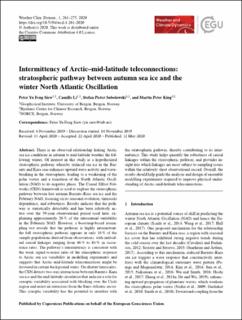| dc.contributor.author | Siew, Yu Feng | |
| dc.contributor.author | Li, Camille | |
| dc.contributor.author | Sobolowski, Stefan Pieter | |
| dc.contributor.author | King, Martin Peter | |
| dc.date.accessioned | 2021-08-23T13:29:37Z | |
| dc.date.available | 2021-08-23T13:29:37Z | |
| dc.date.created | 2020-10-09T18:24:33Z | |
| dc.date.issued | 2020 | |
| dc.identifier.citation | Weather and Climate Dynamics (WCD). 2020, 1 261-275. | en_US |
| dc.identifier.uri | https://hdl.handle.net/11250/2770808 | |
| dc.description.abstract | There is an observed relationship linking Arctic sea ice conditions in autumn to mid-latitude weather the following winter. Of interest in this study is a hypothesized stratospheric pathway whereby reduced sea ice in the Barents and Kara seas enhances upward wave activity and wave-breaking in the stratosphere, leading to a weakening of the polar vortex and a transition of the North Atlantic Oscillation (NAO) to its negative phase. The Causal Effect Networks (CEN) framework is used to explore the stratospheric pathway between late autumn Barents–Kara sea ice and the February NAO, focusing on its seasonal evolution, timescale dependence, and robustness. Results indicate that the pathway is statistically detectable and has been relatively active over the 39-year observational period used here, explaining approximately 26 % of the interannual variability in the February NAO. However, a bootstrap-based resampling test reveals that the pathway is highly intermittent: the full stratospheric pathway appears in only 16 % of the sample populations derived from observations, with individual causal linkages ranging from 46 % to 84 % in occurrence rates. The pathway's intermittency is consistent with the weak signal-to-noise ratio of the atmospheric response to Arctic sea ice variability in modelling experiments and suggests that Arctic–mid-latitude teleconnections might be favoured in certain background states. On shorter timescales, the CEN detects two-way interactions between Barents–Kara sea ice and the mid-latitude circulation that indicate a role for synoptic variability associated with blocking over the Urals region and moist air intrusions from the Euro-Atlantic sector. This synoptic variability has the potential to interfere with the stratospheric pathway, thereby contributing to its intermittency. This study helps quantify the robustness of causal linkages within the stratospheric pathway, and provides insight into which linkages are most subject to sampling issues within the relatively short observational record. Overall, the results should help guide the analysis and design of ensemble modelling experiments required to improve physical understanding of Arctic–mid-latitude teleconnections. | en_US |
| dc.language.iso | eng | en_US |
| dc.rights | Navngivelse 4.0 Internasjonal | * |
| dc.rights | Navngivelse 4.0 Internasjonal | * |
| dc.rights.uri | http://creativecommons.org/licenses/by/4.0/deed.no | * |
| dc.title | Intermittency of Arctic–mid-latitude teleconnections: stratospheric pathway between autumn sea ice and the winter North Atlantic Oscillation | en_US |
| dc.type | Peer reviewed | en_US |
| dc.type | Journal article | en_US |
| dc.rights.holder | © 2020, Authors | |
| dc.description.version | publishedVersion | en_US |
| cristin.ispublished | true | |
| cristin.fulltext | original | |
| cristin.qualitycode | 1 | |
| dc.identifier.doi | 10.5194/wcd-1-261-2020 | |
| dc.identifier.cristin | 1838568 | |
| dc.source.journal | Weather and Climate Dynamics (WCD) | en_US |
| dc.source.volume | 1 | en_US |
| dc.source.pagenumber | 261-275 | en_US |
| dc.relation.project | Norges forskningsråd: 255027 | en_US |
| dc.relation.project | Norges forskningsråd: 272721 | en_US |

